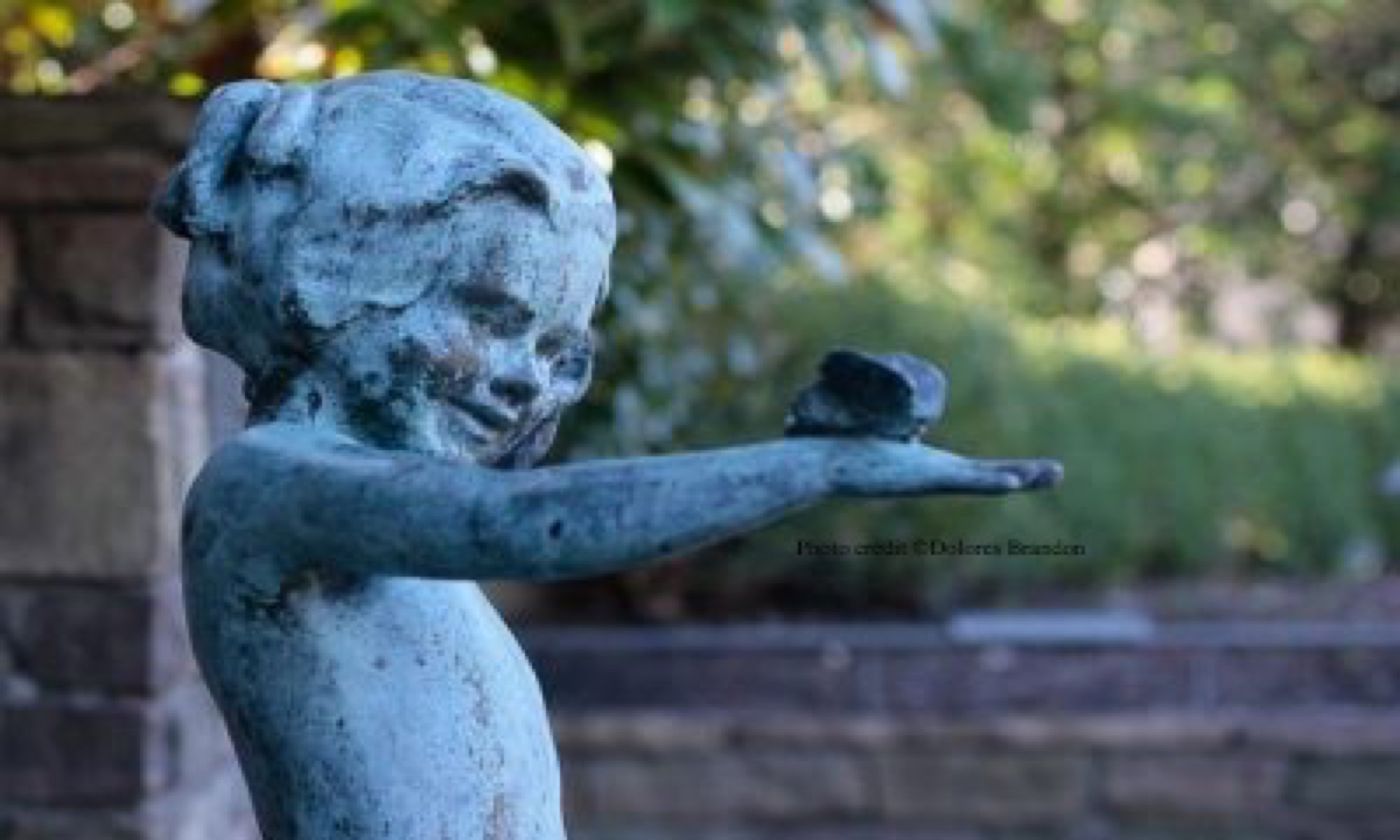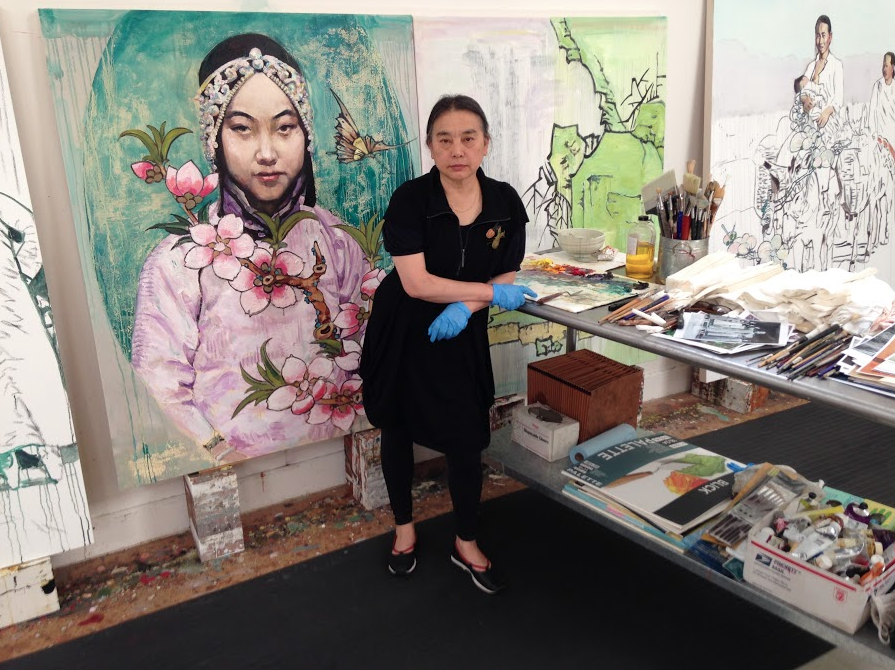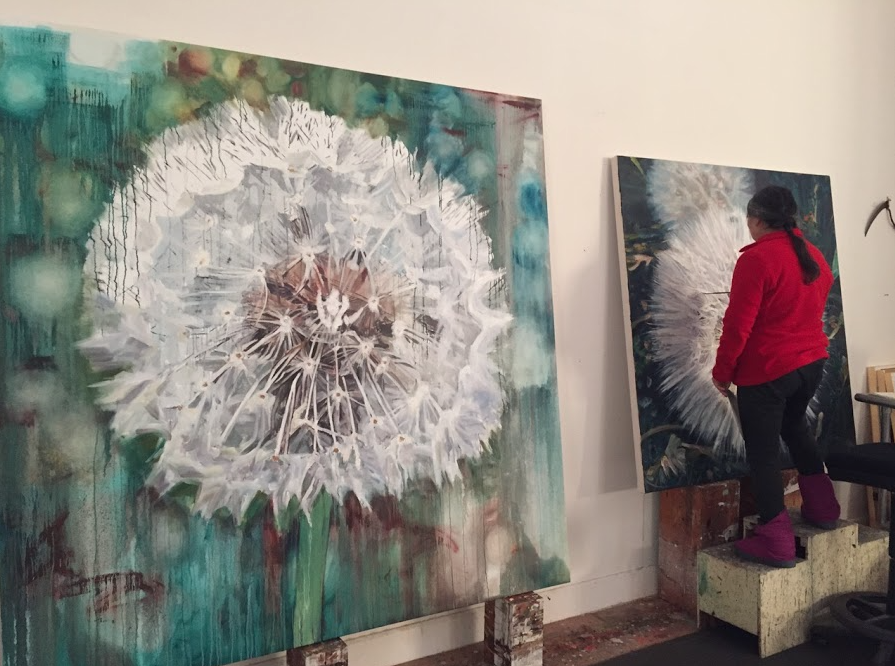Painter, muralist, installation artist.
When I met Hung Liu in 1994 she was a rising American “star” artist celebrating THE YEAR OF THE DOG, her one-woman show at the Bernice Steinbaum Gallery in New York, NY.
Born in China, in 1948, Liu spent formative career years (1968-72) in proletarian “re-education” – that is, working alongside peasants in rice and wheat fields seven days a week . Singularly determined to be an artist despite the restrictions on expression imposed by the Chinese Cultural Revolution , Liu took photographs and drew portraits of local farmers and the families with whom she worked. Those drawings were kept in notebooks and pads, and the photographs were not printed until forty years later.
Coming to the United States in 1984, Liu entered graduate studies in visual arts at the University of California San Diego and by 1990 she was a citizen of the United States
Ever mindful of the diverse cultural traditions and the historically significant events she is living through, Hung Liu says “I bear the burden of history”.
Driven to document elements of that history visually, Liu’s art is often inspired by a deep interest in photography. Fascinated with the ways in which being photographed changed human consciousness , Liu reinterprets the “hidden” cultural histories found in photographic archives both here and in China.
For a comprehensive overview of Hung Liu’s life and work (to date) please visit
Hung Liu’s personal website
http://www.hungliu.com
YOUTUBE
https://www.youtube.com/watch?v=Rt7ctO9oECA
Jordan Schnitzer Museum Artist’s Talk given by Hung Liu March 17, 2015
In her own words
The following highlights are selected from an extended interview conducted and recorded by Dolores Brandon at the Bernice Steinbaum Gallery, New York, NY March 15, 1994
DOLORES BRANDON: Tell me about the more formal concerns motivating your work.
HUNG LIU: My paintings have a lot to do with photographs. Three or four years after arriving in the US, I found a book called THE FACE OF CHINA – a collection of photographs taken by foreigners (European as well as American)in China from the mid-19th C on into the early 20th C – (years 1868 to about 1912). I was really shocked by the imagery. It was so familiar and yet so foreign because I hadn’t seen this kind of documentation in any Chinese archive, ever. There were weddings, family photographs, even a street execution. But we [Chinese] have never seen anything like them in China. These photographs are like souvenirs [but] more than souvenirs because they use the camera to capture moments of Chinese activities.
I remember one photograph, in particular, taken in Shanghai in 1865. It’s of a merchant’s family – a man with three sons, a wife and a daughter. On the left [side of the photo] was the female group, mother and daughter, and on the right the male members in the family, and it’s like two worlds, a very interesting setting. All the male members in this photograph looked directly at the camera lens. In the west [that would be] called [giving] eye contact; they look directly, they have direct connection, but women look down, women look away. And the clothing,also very different: men, relatively comfortable and casual even formal but serious and formal while the women are all wearing embroidered clothing, with tiny bound feet, heavy make-up on their faces, very much like wearing a mask.
BRANDON: And these images were foreign to you?
LIU: Well, first off, I think China (an ancient culture) was behind the [western] world in terms of development; so, when foreigners brought their cameras – the latest advanced devices – they had the advantage to take, to possess (I would say) the imagery. Because they collected the imagery from China, the ownership was clear. When I saw it, I felt – I’m Chinese but I’ve never seen anything [like this] neither have my friends, my family members.
I had some intuition then that I’d like to do some work based on old photographs. So, between 1989-93 I took two research trips to China where I discovered a lot of old, historical photographs which I sorted into two important groups that I transformed into paintings. One group [documents] young Chinese prostitutes [circa early 20th C]. Taken in a photo studio lab, you could say these women were posing against the backdrop of a theatrical setting – a European landscape with Victorian furniture, curtains, some props like fake flowers and other accoutrements.
BRANDON: Were paintings in THE YEAR OF THE DOG exhibit informed by those photos?
LIU: Yes, and no. I have only one painting [in this exhibit] based on the prostitute photograph: the title uses French “deux amis”. I think it’s playing on the exoticism, [applied to an] advertising strategy.
In order to sell young women, they used this strategy of advertising [posed] in a photo studio – the two women together. I’m sure they were given orders to look at the camera directly. {Traditionally, as noted earlier, Chinese women would avert their eyes.]
Photography was a new, very exotic technology back then; so the young prostitutes were put on stage almost – to lure the potential clients. Their unknown story, unknown identity really haunted me.
Anonymity plays a very important role in my work. These anonymous people become my heroes,
BRANDON: When I first entered THE YEAR OF THE DOG exhibit, I immediately sensed a photographic basis: for me, many of the paintings delivered the impact of a movie close-up shot. I was very taken with the women’s presence – in part because of the really intense vibration that you, the artist, were able to capture in the skin and the eyes. It’s like a film close-up where the inner life is made fully palpable.
LIU: I just looked so hard into those old blurry images. I couldn’t find a lot of detail. The lack of information about these young women gave me a lot of passion and power, even frustration.
I tried very hard to empower them, to give back something they never had. Now in a gallery, a museum context, they’re like actresses on stage, they have the power, they give the gaze back to the viewer. I feel that I’ve done something [for them].
Several other paintings in THE YEAR OF THE DOG are based on photographs found in magazines and periodicals published in China in the 1920-30’s. These people are modernized, westernized; for Chinese women to be Westernized in the 1920’s and 30s was pretty exotic.
BRANDON: You also use personal archival photos to make paintings of your own family. Talk about that.
LIU: Yes. There’s one painting in this show I call, MA. It’s a Chinese mother based on a snapshot of my own mother visiting a tourist place, not too far from Beijing. She is standing alone with a mountain behind her – a mother carrying a mountain.
I treated the background, mountains, trees and pavilion as if I was doing traditional Chinese landscape. Then I let the paint run not only over the landscape, but also over her face, her shoulders, her body.
I think it’s very appropriate for her life because she has been living under the Communist Party leadership for some thirty years. She lost her husband – my father – in her late twenties. Under political pressure, she was forced to divorce him. Everything is on her shoulders.
People often ask me about my painting technique. I use a lot of washes and drippings, which some interpret to be like tears. It’s very interesting: in Chinese, when we use the verb to develop a photograph, the word we use is best translated to wash. We say we’re going to wash a photograph. You have to use a lot of water to wash the imagery out of a photograph.
Overall, it’s very hard to say that my washes and drippings represent just one thing. To me it’s like a flood , a washing out of the memory, the pain AND the happiness. It’s like a curtain, like a veil, a filter – the blurring of memory, of history and disillusionment with the past.
BRANDON: How might you generalize what your goals are as an artist?
LIU: What I’m doing is trying to understand my new situation (here in the United States). Fundamentally, I really want to use my art to explore a lot of issues, maybe a lot of questions.
All those years I was living under the rules of the Cultural Revolution in China I hated politics so much. I thought – I just want to be an artist, an artist has nothing to do with politics. I tried to get away as far [from politics] as I could. Now I think that every act has a political overtone. So the body of work included in THE YEAR OF THE DOG is [my way of] looking at politics overall.
BRANDON: What might be the primary issues you are exploring?
LIU: There’s a piece in this show called BLUE BOY. I discovered [there were] twelve steps of make up required for a famous Peking Opera actor who played only female characters – twelve steps of makeup.
On the first step he is an authentic boy, a young man. Step by step he transforms himself into a very beautiful sexy female character. This kind of art form in Chinese tradition, Chinese culture, has a lot of contemporary overtones to it: for example, transvestite people dress men like women, and the other way around. All sexuality is about masks – straight, gay. Make-up is [also] about mask – how you dress up, how you want to be represented, how you want to project yourself, but maybe that’s not who you really are.
I am in the process of understanding myself. Maybe I won’t fit into some kind of stereotype – she is Chinese woman, some kind of feminist; she is supposed to do that kind of work, supposed to say a certain kind of thing. I want to be honest to myself first.
A lot of memories come back [as I explore the past] and those [images] are superimposed with the present in my work.
THE END
Please visit Hung Liu online: http://www.hungliu.com



hermoso!!!
Not sure when you posted your comment BUT thank you.
I have been remiss in checking for comments.
Do you know Hung Liu?
Many thanks
dolores
P.S. IF you would like to be in touch, my email is usually better brandon.dolores@gmail.com